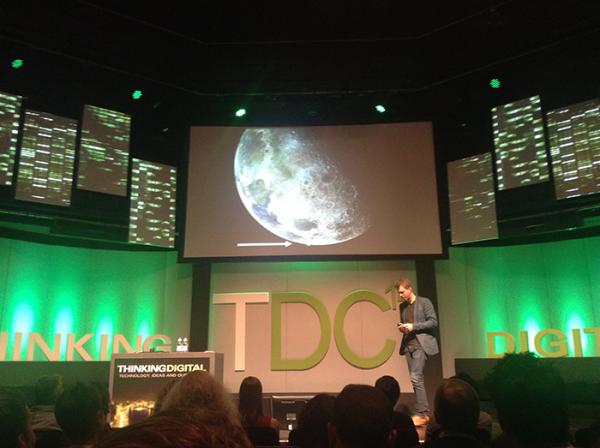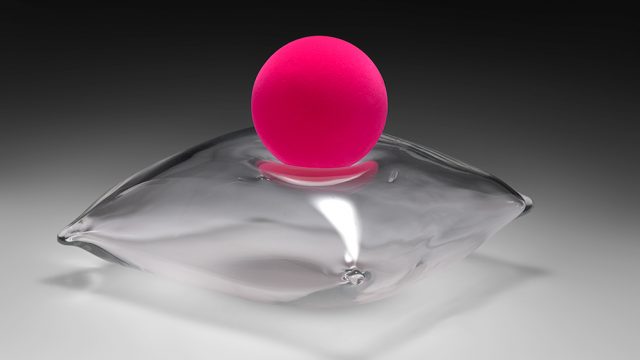Sitting through the 2nd day of the Thinking Digital conference at Sage Gateshead was rather like settling down in front of the latest Hollywood blockbuster. With presentations ranging from virtual reality, disease and money to lunar architecture, blood, and the rise of machines, by people with job titles such as Lunar Architect and Machine Educator, it certainly made for exciting viewing.

But first we start in more familiar territory, in the present, in a museum or large art gallery looking at digital art.
Or rather, we don’t.
As Conrad Bodman, Guest Curator of this summer’s Digital Revolution exhibition at the Barbican Centre, noted, despite the revolutionary impact of digital technology on the worlds of art, film, music and the performing arts, there is no large, single venue in the UK dedicated to digital media. Indeed, there is a general reluctance for digital culture to even be accepted into the art/design establishment. There has been some progressive activity in this field: the Science Museum has a digital space, Tate is commissioning digital art, and here at the V&A we are busy collecting digital work such as wearable tech and the 3D printed gun. But why this reluctance? Perhaps, Conrad says, this is because of the challenges of showing digital art. Digital natives want to engage with digital art; they want accessibility, immediacy and a collective shared experience – one which the silent, reverential gallery space hasn’t traditionally provided.
But, if Carlos Ulloa, Interactive Designer and Co-founder of HelloEnjoy, has his way, it wont be ‘experiences’ we will be looking to have in the future, but ‘presence’. In a compelling but slightly frightening talk, Carlos predicted that the future of 3D and virtual reality lay in ‘presence tech’ where the digital environment is so perfect that the challenge to the user is to convince yourself you aren’t there. Or to use Carlos’ own words: ‘’Experience’ is when you’re trying to convince the brain it’s somewhere else. ‘Presence’ is when you have to convince the brain its not’. 3D and VR remain underused technologies in museum/art galleries – It will be interesting to see how this technology will be adopted in the future.
Continuing a data theme from Day 1 of the conference, Susan Mulcahy, Bioengineer and coder, revealed how ‘big/high resolution’ data was being used to better understand blood flow and the physiological signals from the human body following traumatic brain injury. Even more impressive was Jonathan O’Halloran’s vision of a disease-free future. Jonathan is developing a handheld device that could detect diseases such as malaria in only 15 minutes. This device would be backed-up by an ‘internet of life’ where ‘bio-APIs’ collect real-time data worldwide to map disease mutations and emerging pathogens.
Elsewhere, equally impressive was the sheer scale of some of the digital projects currently being undertaken. Mark Dearnley, Chief Digital and Information Officer at HMRC revealed his department’s ambitious plans to fully digitise Customs and Revenue, providing a joined-up, user-centred service for its 41 million users across all platforms. Not only will doing anything ‘taxy’ now be as easy as online banking but the taxpayer will save a whopping £85 million a year in print costs alone. Good news.
But having a vision is the easy part; what is more difficult is the delivery. Mark was quick to acknowledge the massive internal cultural changes that lie ahead at HMRC and the importance of an agile approach and incremental change.
Another digital project with a grand vision and a very ingenious delivery strategy, is the architectural firm, Foster + Partners’ plan to build a base on the moon using 3D printer robots. This plan involves a team of robots scooping up lunar soil and printing a lightweight protective structure over an inflatable dome, taking roughly 3 months to build a house fit for 4 people. Foster + Partners have a history of designing for extreme climates but the moon is a far different proposition with any habitation having to survive high levels of radiation, extreme temperature fluctuations and regular meteorite impacts. And then there’s the transportation costs – at $200, 000 per kilogram this isn’t your regular man and a van job.
And so two inspiring days at the Sage sadly came to a close. Two days of big brains and big ideas. I had been mightily impressed at the scale and vision of some of the digital projects being undertaken and it was also nice to be reminded of the transformative powers of technology – how digital is helping to shape the world around us as well as asking exciting questions about the future. It’s a privilege to be part of this community.
Thank you Thinking Digital.



